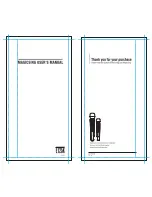
CEBORA S.p.A.
20
FIRING PULSES FOR SCR1 (47) AND SCR2 (47) TEST.
NOTE
In AC operation the output voltage becomes alternating only in presence of output current,
thus SCR2 is not driven in AC operation with open-circuit power source.
Shut-off board (48), connector J1, terminals 2 and 4 (gnd) = fig. 5.2.2a, pulses for SCR1, with
AC/DC selector switch (30) in the “0” position. With AC/DC selector switch (30) in pos. AC
or DC the waveform becomes fig. 5.2.2b.
Correct?
Shut-off board (48), connector J3, terminals 4 and 6 (gnd) = fig. 5.2.3a, pulses for SCR2 with
AC/DC selector switch (30) in the “0” position. With AC/DC selector switch (30) in pos. DC
the waveform becomes fig. 5.2.3b; SCR2 is not driven with selector switch in position AC.
YES
NO
♦
Check the wiring between J1 shut-off board (48) and SCR1 (47), and between J3
shut-off board (48) and SCR2 (47).
♦
Check the wiring between J1, J3 of shut-off board (48) and J7 of control board
(40).
♦
With power source off, temporarily disconnect terminals 2 and 4 of J1 on shut-off
board (48) and check the resistance between patch terminals removed from J1
(gate – cathode junction of SCR1). Correct values = approximately 20 ohm. If
incorrect, replace SCR1 (47) or the complete thyristor group.
♦
With power source off, temporarily disconnect terminals 4 and 6 of J3 on shut-off
board (48) and check the resistance between patch terminals removed from J3
(gate – cathode junction of SCR2). Correct values = approximately 20 ohm. If
incorrect, replace SCR2 (47) or the complete thyristor group.
♦
Check for the presence and phase of the 16 Vac synchronization signal on J2 of
control board (40). This signal must have the proper phase ratio with the
secondary voltage of the power transformer (46). If incorrect, reverse the wires of
the primary circuit of the service transformer (4) on terminal board (52), or those
on J3 or J4 of fuse board (4), or those on J2 of control board (40).
♦
Check presence of 7 Vac supply voltage, if necessary performing the CONTROL
BOARD (40) POWER SUPPLY TEST, par. 3.3.1, especially those related to J6.
♦
Replace control (40) and/or shut-off (48) boards.
♦
Check connections between secondary windings of the power transformer (46), thyristor
group (47), inductor (50), AC/DC selector switch (30), HF transformer (28) and output
terminals (-)(AB) and (+)(AC) of the power source. If you find loose connections, tighten
them and replace any components with damaged terminals.
♦
Check operation of the AC/DC selector switch (30), making sure the closing sequence of the
contacts matches the table in the electrical diagram in par. 5.1.
♦
With the power source off, temporarily disconnect the thyristor group (47) and make sure the
thyristor group (47) is intact by measuring the resistance between terminals (A), (-) and (+) of
the thyristor group (47). Correct values = >Mohm for each measurement point, also reversing
the test probes. If incorrect replace the defective thyristor or the entire thyristor group (47).
♦
With AC/DC selector switch (30) in the “0” position, with the power source off, make sure
the diode module is intact by measuring the resistance on the following points (see drawing
par. 5.11):
3.302.221
15/01/07
Summary of Contents for TIG 250 AC-DC
Page 1: ...CEBORA S p A 1 TIG 250 AC DC POWER SOURCE art 236 76 SERVICE MANUAL 3 302 221 15 01 07 ...
Page 35: ......
Page 37: ......
















































